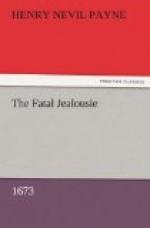Back in England, possibly by mid-May, 1672, Payne must have plunged at once into work for the theater. The Fatal Jealousy was performed at the Duke’s Theatre in Dorset Garden in August 1672 and The Morning Ramble was shown at the same theater three months later. Both plays were performed before the King (Allerdyce Nicoll, A History of Restoration Drama, 1923, p. 309). Payne’s third and last play, The Siege of Constantinople, which reached the stage in November 1674, is of particular interest in view of his long association with the cause of James, Duke of York. Payne found his plot in the General Historie of the Turkes by Knolles, but he altered history to produce a work which would compliment James. It is significant that there is no prototype in Knolles for Thomazo (James), the brother of the last Christian emperor of Constantinople (Charles). At the end of the play the Turks conquer the city (sc., the Dutch and London) and the Emperor is slain. Here was a warning to Englishmen of what would happen if their double-dealing “Lord Chancellor” (Shaftesbury)—the villain of the piece—were to succeed in alienating the two royal brothers.
During the years 1678-1680 Payne’s name dodges in and out of the thousands of words written about the Popish plot. He was pretty certainly a friend of Edward Coleman (Secretary to the Duchess of York) who was executed for treason in December, 1678. After a hearing before the Privy Council, Payne was held over for trial and imprisoned in the King’s Bench. Confinement did not in the least hinder him from giving aid to the Catholic party in organizing its counter-attack. According to Mr. Tho. Dangerfields Particular Narrative (1679) he was one of the chief devisers of the Presbyterian Plot and, as “chief Pen-man” for the Catholics, the author of several “scandalous books” about their enemies. Payne was again before the Privy Council in November 1679, but eventually all the principals in the Catholic plots to discredit the government were released.
After the accession of James II Payne kept more respectable company. References to him during these years say nothing about any work for the theater, but his pen was still busy—from 1685 to 1687 in the cause of religious toleration. In 1685 the Duke of Buckingham published A Short Discourse upon the Reasonableness of Men’s having a Religion or Worship of God. A portion of this pamphlet had been written as a letter to Payne. When Buckingham’s work brought on a pamphlet war, Payne (together with William Penn) rushed to his defence. The debate grew hotter when James made the first Declaration of Indulgence in April 1687. Payne was one of the chief controversialists in the war of words that followed. Another literary friend of these years, and an extravagant admirer of his devotion to the Stuarts, was Aphra Behn. She dedicated her Fair Jilt to Payne in 1688 in terms which suggest that he had favored her in tangible ways.




